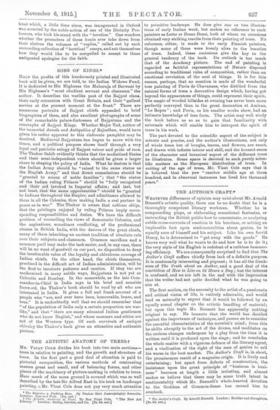THE ARTISTIC ANATOMY OF TREES.f Mn. VICAT COLE divides his
book into two main sections— trees in relation to painting, and the growth and structure of trees. In the first part a good deal of attention is paid to pictorial composition, the various methods of contrasting masses great and small, and of balancing forms, and other pieces of the machinery of picture-making in relation to trees. Here much of the same ground is covered which was so well described by the late Sir Alfred East in his book on landscape painting, 4) Mr. Vicat Cole does not pay very much attention
Thu Raj puts: a Fighting Rama. By Thakur Shri Jeserajeinghji Seeeodia. Loudon: East and West. [21s. net.] t Tho Arti:+tio Anatu mu of Trues. By Res Vicat Cole. " The NOW Art library." London; Seeley, Service, and Co. Rs. Bd. net.] to primitive landscape. He does give one or two illustra- tions of early Italian work, but makes no reference to such painters as Lotto or Dosso Dossi, both of whom on occasions obtained very striking results from their painting of trees. No reference, either, is made to the early Flemish painters, though some of these were keenly alive to the beauties of trees. Indeed, these omissions give the key to the general tendency of the book. Its outlook is too much that of the Academy picture. The end of painting is regarded as faithful representations of Nature disposed according to traditional rules of composition, rather than an emotional revelation of the soul of things. It is for this reason, perhaps, that no mention is made of the -wonderful tree painting of Puvis de Ohavannes, who distilled from the natural forma of trees a decorative design which, having got beyond the appearances of things, could represent their spirit. The magic of wooded hillsides at evening has never been more perfectly conveyed than in the great decoration at Amiens, "Le Repos " ; and Puvis, as his smaller works show, had an intimate knowledge of tree form. The artist may well study the book before us so as to gain that familiarity with externals which will enable him to interpret the spirit of trees in his work.
The part devoted to the scientific aspect of the subject is minute and precise, and the author's illustrations, not only of whole trees but of boughs, leaves, and flowers, are exact, and drawn with infinite labour and skill, and the keenest sense of the character and botanical aspect of the different trees he illustrates. Some space is devoted to such purely scien- tific matters as the European distribution of trees. In writing of the age of trees, Mr. Vicat Cole says that it is believed that the yew " reaches middle age at three hundred, and in abnormal instances has lived five thousand years."
















































 Previous page
Previous page